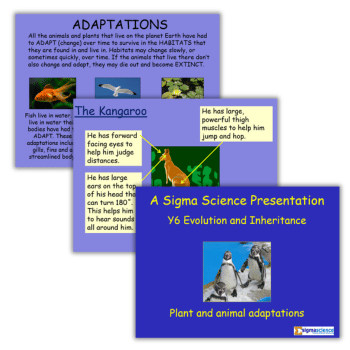This Year 6 evolution and inheritance PowerPoint presentation looks at how plants and animals adapt.
It explains that all animals and plants on Earth have had to change over time to survive in the habitats in which they are found.
It also talks about how habitats may change slowly, or sometimes quickly, over time. And that if the animals don’t also change and adapt, they may die out and become extinct.
The English national curriculum for Year 6 science includes key concepts related to evolution and inheritance. These concepts are designed to give students an understanding of how living things have changed over time and how traits are passed from one generation to the next.
Year 6 evolution and inheritance examples
Kangaroo
- Forward-facing eyes to judge distances
- Large ears that can turn 180 degrees to hear sounds all around
- Large powerful thigh muscles for jumping and hopping
- Long, thick tail for balance
Thistle
- Has a flower to attract insects and help with pollination
- Spikes prevent animals eating them
- Green leaves make food through photosynthesis
Brown owl
- Camouflaged feathers for hunting prey
- Bones that weigh less than its feathers to help it fly and save energy
- Large eyes on the front of its head to see prey
- Sharp beak, ideal for cutting and ripping meat
Find out more about Sigma Science at sigmascience.co.uk.










